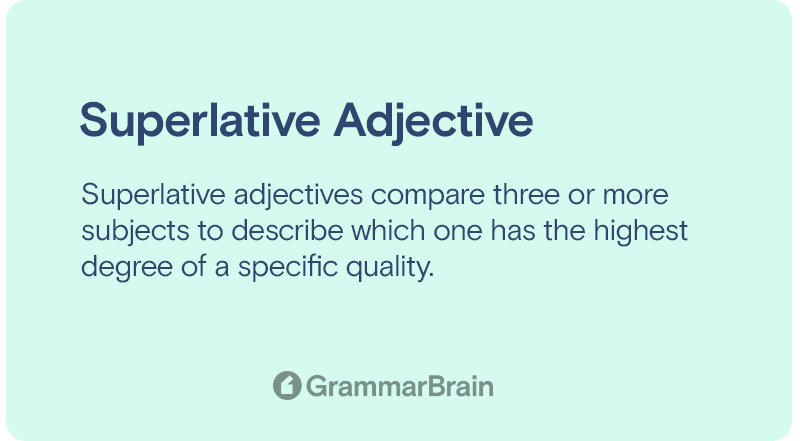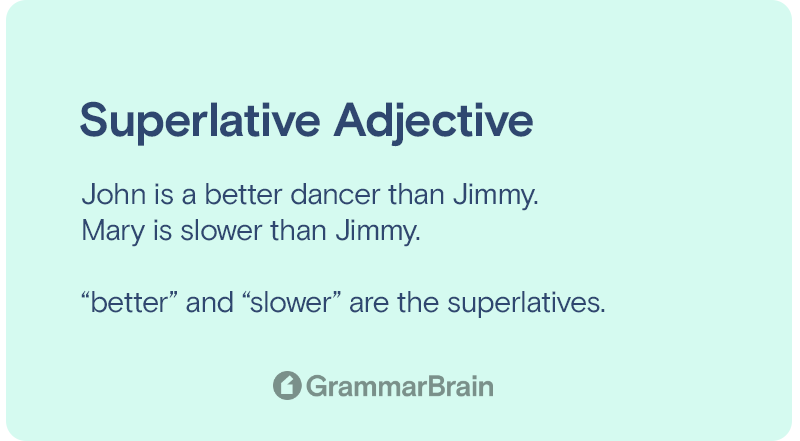What is a superlative adjective? How does a superlative adjective work? And how does it differ from common adjectives? Adjectives are words that modify nouns and pronouns. These words tell us something remarkable, noticeable, or important about a subject.
For example:
- Mary is wearing a red dress.
In this sentence, the adjective red modifies the noun dress.
Adjectives play another important role in the English language. These words tell us where something stands with respect to something else.
Consider the following example:
- Mary was wearing a red dress. It was redder than most of the dresses I have seen, but not the reddest color I have ever witnessed.
In these sentences, we can see all three degrees of the adjective red – positive, comparative, and superlative.
Superlative adjectives describe the highest possible degree of the adjective. Nothing can be redder than the reddest color. There’s only one best player in a team and only one tastiest dish in a restaurant.
Let’s learn more about superlative adjectives and how to use them in sentences.

What are superlative adjectives?
Superlative adjectives compare three or more subjects to describe which one has the highest degree of a specific quality. It describes the highest and most extreme degree of any feature, quality, or attribute.
Here’s a simple example:
- Usain Bolt is the fastest human in the world
The above sentence tells us that Usain Bolt is faster than anyone else in the world. For the adjective fast, the comparative and superlative degrees are faster and fastest respectively.
The word ‘superlative‘ is itself an adjective describing something of the highest degree.
Consider the following sentence:
- That was a superlative performance by our team.
The above sentence talks about a performance that’s better than any other performance by the team. However, the word superlative itself is a positive adjective, not comparative or superlative.

Understanding superlative adjectives
Superlative adjectives are always used in scenarios of comparison. More importantly, the comparison has to be among three or more things. If there are only two subjects, we use the comparative degree of an adjective instead of its superlative degree.
For example:
- John is a better dancer than Jimmy.
- Mary is slower than Jimmy.
Since the comparison in the above sentences is between two subjects, using the superlative degree of the adjectives good and slow will be incorrect. When there are three or more subjects, we can use the superlative degree of an adjective.
Consider the following examples:
- John is a better dancer than Jimmy, but Adam is the best among them.
- Mary is slower than Jimmy. However, Jack is the slowest.
All adjectives have a superlative degree. When there’s no specific word for the superlative degree of an adjective, we modify the adjectives with quantifiers more and most.
For example:
- France is beautiful, but Italy is the most beautiful place I have been to.
- It was the most thrilling experience of my life.
Simply put, superlative adjectives tell us that something is better (in a good or bad way) than everything else in its category.
Let’s learn more about identifying and using superlative adjectives.

How to form superlative adjectives from positive adjectives?
Positive adjectives are the base form of all adjectives. Good, bad, simple, easy, etc. are examples of adjectives in their positive forms. Positive adjectives don’t compare the subject they modify with other subjects.
Comparative adjectives, on the other hand, compare two subjects. Superlative adjectives compare more than two subjects.
There are specific rules in English grammar on forming comparative and superlative adjectives from positive adjectives. Let’s learn more about these rules.
Rules on forming superlative adjectives
The most common method of forming superlative adjectives is by adding the suffix -est to positive adjectives.
Here are some examples of it:
Positive > Comparative > Superlative
- Good > Better > Best
- Simple > Simpler > Simplest
- Fast > Faster > Fastest
- Slow > Slower > Slowest
- Warm > Warmer > Warmest
- Sad > Sadder > Saddest
- Cruel > Crueler > Cruelest
- Smart > Smarter > Smartest
Another method of forming superlative adjectives involves the use of the quantifiers more and most. Here are some examples:
Positive > Comparative > Superlative
- Beautiful > more beautiful > most beautiful
- Believable > more believable > most believable
- Fun > more fun > most fun
- Curious > more curious > most curious
We can follow the same template with the quantifiers less and least:
- Fearful > less fearful > least fearful
- Energetic > less energetic > least energetic
- Conceivable > less conceivable > least conceivable
- Active > less active > least active
General rules for superlative adjectives
- Most single-syllable adjectives get their superlative form with the addition of the suffix -est
- For syllables ending with ‘y’, the ‘y’ is swapped for an ‘i’ + -est
- Adjectives ending with -er, -le, or -ow get their superlative degree with the addition of the suffix -est
- Adjectives with more than two syllables generally get their superlative degrees with words like more, most, less, and least.
By keeping these broad rules in mind, you can use grammatically correct superlative adjectives in your sentences.
FAQs
What are superlative adjectives?
Superlative adjectives are adjectives that describe the highest degree of an adjective. For example, most beautiful is the highest degree of the adjective beautiful.
These common adjectives have completely irregular comparative and superlative forms.
How are superlative adjectives formed?
Superlative adjectives are formed with words like less, least, better and best, or with the addition of the suffix -est.
When words end in a n “-er,” it’s a good indication that you’re looking at a comparative adjective.
Which words are made superlative with the suffix -est?
Generally, single and double-syllable adjectives get the suffix -est in the superlative forms.
What are irregular superlative adjectives?
Words like “good, bad, well, old” are irregular superlative forms.
Are adjectives all about comparison?
Adjectives typically take comparison to the highest or lowest degree you can. In English, when we compare the way that two things are carried out, we often use the comparative form of an adverb.
What are one syllable adjectives?
If a consonant has a constant + single vowel +consonant spelling, the constant must get doubled before adding the suffix ending.
Sources
- What Is A Superlative Adjective? | Thesaurus.com
- Superlative Adjectives | Grammar | EnglishClub
- Comparative and superlative adjectives | LearnEnglish (britishcouncil.org)
- Positive, Comparative & Superlative Adjectives | Ginger (gingersoftware.com)Most, the most, mostly – Grammar – Cambridge Dictionary
Inside this article
Fact checked:
Content is rigorously reviewed by a team of qualified and experienced fact checkers. Fact checkers review articles for factual accuracy, relevance, and timeliness. Learn more.
Core lessons
Glossary
- Abstract Noun
- Accusative Case
- Anecdote
- Antonym
- Active Sentence
- Adverb
- Adjective
- Allegory
- Alliteration
- Adjective Clause
- Adjective Phrase
- Ampersand
- Anastrophe
- Adverbial Clause
- Appositive Phrase
- Clause
- Compound Adjective
- Complex Sentence
- Compound Words
- Compound Predicate
- Common Noun
- Comparative Adjective
- Comparative and Superlative
- Compound Noun
- Compound Subject
- Compound Sentence
- Copular Verb
- Collective Noun
- Colloquialism
- Conciseness
- Consonance
- Conditional
- Concrete Noun
- Conjunction
- Conjugation
- Conditional Sentence
- Comma Splice
- Correlative Conjunction
- Coordinating Conjunction
- Coordinate Adjective
- Cumulative Adjective
- Dative Case
- Determiner
- Declarative Sentence
- Declarative Statement
- Direct Object Pronoun
- Direct Object
- Diction
- Diphthong
- Dangling Modifier
- Demonstrative Pronoun
- Demonstrative Adjective
- Direct Characterization
- Definite Article
- Doublespeak
- False Dilemma Fallacy
- Future Perfect Progressive
- Future Simple
- Future Perfect Continuous
- Future Perfect
- First Conditional
- Irregular Adjective
- Irregular Verb
- Imperative Sentence
- Indefinite Article
- Intransitive Verb
- Introductory Phrase
- Indefinite Pronoun
- Indirect Characterization
- Interrogative Sentence
- Intensive Pronoun
- Inanimate Object
- Indefinite Tense
- Infinitive Phrase
- Interjection
- Intensifier
- Infinitive
- Indicative Mood
- Participle
- Parallelism
- Prepositional Phrase
- Past Simple Tense
- Past Continuous Tense
- Past Perfect Tense
- Past Progressive Tense
- Present Simple Tense
- Present Perfect Tense
- Personal Pronoun
- Personification
- Persuasive Writing
- Parallel Structure
- Phrasal Verb
- Predicate Adjective
- Predicate Nominative
- Phonetic Language
- Plural Noun
- Punctuation
- Punctuation Marks
- Preposition
- Preposition of Place
- Parts of Speech
- Possessive Adjective
- Possessive Determiner
- Possessive Case
- Possessive Noun
- Proper Adjective
- Proper Noun
- Present Participle
- Prefix
- Predicate



